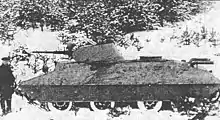BT-SV
The BT-SV ( Bystrohodny Tank-Stalin Voroshilov) was an experimental Soviet light tank. In 1936, Soviet engineer Tsiganov proposed a new high-speed (BT) light tank based on the BT-7. The design was to incorporate sloped armor similar to the T-34, which was also being developed at the time, and a transmission identical to that of the BT-7. The armor was angled at around 15°-58°. It could protect the tank from 45mm rounds. Only two prototypes were built, both of which saw field testing. The vehicle never saw mass production, and resources were instead focused on the production of the T-34 medium tank. All work on this project was abandoned when designer Tsiganov was arrested during purges in 1938.
| BT-SV / BT-SW-2 | |
|---|---|
 BT-SV | |
| Type | Light cavalry tank |
| Place of origin | Soviet Union |
| Production history | |
| Designer | Tsyganov group |
| Designed | 1937-1938 |
| Specifications (BT-SV) | |
| Mass | 25 tons |
| Length | 562 cm |
| Width | 280 cm |
| Height | 217.5 cm |
| Crew | 4 |
| Armour | 16-25 mm |
Main armament | 45-mm 20KL tank gun |
Secondary armament | 7.62-mm DT MG |
| Engine | Model M-17T 500 hp |
| Power/weight | 20 hp/tonne |
| Suspension | Christie suspension |
Operational range | 120 km |
| Maximum speed | 52 km/h (32.3 mph) |
This article is issued from Wikipedia. The text is licensed under Creative Commons - Attribution - Sharealike. Additional terms may apply for the media files.